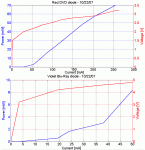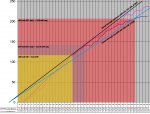Hi all,
I just measured my red DVD LD power and Bluray LD power yesterday -- Luckily we've got a few Scientech Laser Calorimeters in my lab at MIT - We use them for measuring millimeter wave sources, "Masers". I don't know when/if they are calibrated right, though, as the numbers came out disappointingly low (see plots below). I know the Aixiz housing lens has a terrible obstruction in front of the lens, so I took it off and positioned the laser just 0.5" or so from the calorimeter surface so it collected all the light. I was able to get reproducable precision to within 0.2mW, so accuracy is really my main concern. Also my red DVD diodes are from Senkat (thanks!).
Anyway, the purpose of the power measurements was to see if I could gain something by using PULSED power to the LD. I'm planning a 2kHz or faster pulse rate so the "choppies" can't be see so easily (the TI TPS75105 current regulator I'll be using turns on in just 33us, so 2kHz is easy; careful, it's a 9-pin BGA only 1.2mm square!).
According to the red DVD laser plot below, I see the following two scenarios:
1. For a peak LD current of Ipk=250mW, 50% duty cycle pulsed, the average current is Iave=125mW. For this, I would get about 68mW(peak) or 34mW(ave). The input power would be Pin=3.2v*250mA=0.8W(peak) and 0.4W(ave), and the efficiency would be Pout/Pin=34mW/0.4W=8.5%.
2. For a CW (100% duty cycle) at I=125mA, V=2.7v and I would get 30mW out. The efficiency would be Pout/Pin=30mW/(2.7*0.125)=30mW/0.34W=8.8%
Appearantly, there's not much difference between the two for the DVD diode, which I think is due to the very linear slope of Pout vs. I. The story is different for the blu-ray...
For the Blu-Ray diode measurements, same scenarios, different numbers:
1. Pulsed: Ipk=50mA at 50% D.C., Iave=25mA, V=4.8v. Pout(pk)=8.2mW, Pout(ave)=4.1mW. Efficiency=Pout/Pin=4.1mW/(4.8*0.025)=3.4%.
2. DC: I=25mA, V=4.3v, Pout=1.8mW, efficiency=1.8mW/(4.3*0.025)=1.8%.
Clearly, I get MORE power and MORE efficiency by pulsing it in this case. But why wouldn't I just run it at 50mA all the time (yes, lifetime issues, etc.). Can I pulse it at 70mA and get higher average power than I could using DC at 50mA? Has anyone tried this? I think I remember seeing these are "rated" for something like 50mW (peak) output, but my measurement of 8mW is well below 50mW! (again my calorimeter calibration could be bad, but I don't think it's off by more than a factor of 2). So I wonder how we achieve the "ratings" of these diodes.
So can I gain anything by pulsing it besides efficiency? Efficiency itself is a good reason to pulse for a high power laser, but we WANT all the average power we can get!! The DVD diodes are somehow "rated" for about 250mW pulsed. Has anyone tried pulsing them to 400mA or 500mA, for example?? How do we maximize the average output power??
I just measured my red DVD LD power and Bluray LD power yesterday -- Luckily we've got a few Scientech Laser Calorimeters in my lab at MIT - We use them for measuring millimeter wave sources, "Masers". I don't know when/if they are calibrated right, though, as the numbers came out disappointingly low (see plots below). I know the Aixiz housing lens has a terrible obstruction in front of the lens, so I took it off and positioned the laser just 0.5" or so from the calorimeter surface so it collected all the light. I was able to get reproducable precision to within 0.2mW, so accuracy is really my main concern. Also my red DVD diodes are from Senkat (thanks!).
Anyway, the purpose of the power measurements was to see if I could gain something by using PULSED power to the LD. I'm planning a 2kHz or faster pulse rate so the "choppies" can't be see so easily (the TI TPS75105 current regulator I'll be using turns on in just 33us, so 2kHz is easy; careful, it's a 9-pin BGA only 1.2mm square!).
According to the red DVD laser plot below, I see the following two scenarios:
1. For a peak LD current of Ipk=250mW, 50% duty cycle pulsed, the average current is Iave=125mW. For this, I would get about 68mW(peak) or 34mW(ave). The input power would be Pin=3.2v*250mA=0.8W(peak) and 0.4W(ave), and the efficiency would be Pout/Pin=34mW/0.4W=8.5%.
2. For a CW (100% duty cycle) at I=125mA, V=2.7v and I would get 30mW out. The efficiency would be Pout/Pin=30mW/(2.7*0.125)=30mW/0.34W=8.8%
Appearantly, there's not much difference between the two for the DVD diode, which I think is due to the very linear slope of Pout vs. I. The story is different for the blu-ray...
For the Blu-Ray diode measurements, same scenarios, different numbers:
1. Pulsed: Ipk=50mA at 50% D.C., Iave=25mA, V=4.8v. Pout(pk)=8.2mW, Pout(ave)=4.1mW. Efficiency=Pout/Pin=4.1mW/(4.8*0.025)=3.4%.
2. DC: I=25mA, V=4.3v, Pout=1.8mW, efficiency=1.8mW/(4.3*0.025)=1.8%.
Clearly, I get MORE power and MORE efficiency by pulsing it in this case. But why wouldn't I just run it at 50mA all the time (yes, lifetime issues, etc.). Can I pulse it at 70mA and get higher average power than I could using DC at 50mA? Has anyone tried this? I think I remember seeing these are "rated" for something like 50mW (peak) output, but my measurement of 8mW is well below 50mW! (again my calorimeter calibration could be bad, but I don't think it's off by more than a factor of 2). So I wonder how we achieve the "ratings" of these diodes.
So can I gain anything by pulsing it besides efficiency? Efficiency itself is a good reason to pulse for a high power laser, but we WANT all the average power we can get!! The DVD diodes are somehow "rated" for about 250mW pulsed. Has anyone tried pulsing them to 400mA or 500mA, for example?? How do we maximize the average output power??





